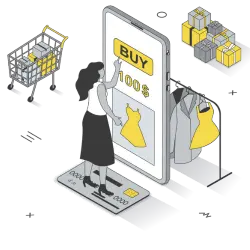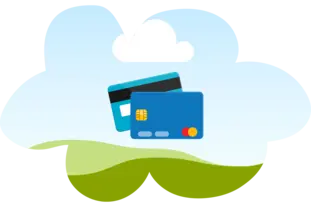TABLE OF CONTENTS
- How to Set up Your Squarespace Site for eCommerce
- Connecting Payment Processors with Squarespace eCommerce
- Pros & Cons of Stripe Squarespace Integration
- Pros & Cons of PayPal Squarespace Integration
- Additional Squarespace Payment Processing Options
- Squarespace Payment Gateway Integrations
- Squarespace Transaction & Processing Fees
- Final Thoughts on Squarespace Credit Card Processing
- Squarespace Payment Processing FAQs
Building websites once required coding experience, web developers, and other resources. Fortunately, web builders like Squarespace now make this process accessible to business owners with limited tech experience. Squarespace offers a range of sleek, modern templates and high-grade features, making building an eCommerce site simple and affordable for businesses of any size. Research suggests Squarespace now has more than 14% of the market share in the eCommerce website niche.[1]Statista. “Market share of leading eCommerce software platforms and technologies worldwide as of July 2022“. Accessed March 25, 2024
If your business wants to build an eCommerce website on Squarespace, you might be curious about the best options for accepting payments. Squarespace makes partnering with third-party payment processors like PayPal and Stripe simple. Meaning that Squarespace itself doesn’t process credit card transactions.
This guide explores how to set up payment processing on your online store. We’ll also examine the pros and cons of each payment option, additional Squarespace payment options, transaction fees, setting up a Squarespace site for eCommerce, and more. Let’s find out how to accept payments on a brand-new Squarespace site!
How to Set up Your Squarespace Site for eCommerce
Before your business accepts credit card payments on Squarespace, you must ensure your new website is enabled for eCommerce. Let’s explore a step-by-step guide for setting up your Squarespace site:

1. Setup a Store with Squarespace Commerce
Once you create a Squarespace account, it’s easy to set up an online store, which will be a central hub for all your online products and services. Squarespace users have access to a range of eCommerce-specific templates. These templates come packed with features, making it easy for customers to navigate products, add goods and services to a basket, view photos of products, and more.
You’ll be ready to add products once you choose your store’s template and add a few customizations.

2. Add Products
After you have the framework for your online store, it’s time to begin adding products. If you’re migrating your business from another eCommerce platform, Squarespace allows you to import products, speeding up the process of setting up your online catalog.
However, the process won’t be too challenging if you add products from scratch. Users can quickly upload products, photos, descriptions, and other core details. Squarespace allows you to customize display options, attracting more customers to your products and services.

3. Add Shipping & Taxes
It’s time to add shipping and tax details to ensure your online store operates smoothly. This will make processing shipping and taxes hassle-free for your business. Squarespace merchants can choose between flat-rate, rates-by-weight, carrier-calculated, and free shipping.

4. Connect a Payment Processor
If your business wants to accept online payments, you must connect with a payment processor. PayPal and Stripe are the two payment processors accessible within Squarespace’s commerce platform. Both offer a range of premium payment features and benefits.
There’s also the option to partner with a third-party eCommerce platform rather than the Squarespace commerce platform. Doing so unlocks access to other payment processors, and we’ll discuss this integration option in another section of this guide.
While the above setup steps may sound complicated, Squarespace makes the entire process quick and stress-free. Again, one of the advantages of working with a web builder like Squarespace is that they take the hassle out of creating an online store.
Connecting Payment Processors with Squarespace eCommerce
As discussed at the start of this guide, Squarespace partners with two major credit card processors for online payments: Stripe and PayPal. Both services offer a range of benefits, so choosing the most suitable option for your business is critical. Let’s explore Stripe and PayPal in more detail below:

Stripe
Once you set up your Squarespace website, adding Stripe as a payment partner only takes a few minutes. On the left side of your home dashboard, choose “Commerce” and select the “Payments” tab on the left side of the sidebar. Select “Connect” to Stripe, which will redirect you to log into your Stripe account. If you already have an account, connecting it to your website is easy. If you don’t have an account, don’t worry; signing up for a new account is simple.
Stripe also allows you to add Apple Pay, meaning your customers can use instant payments directly on their iPhones. Apple Pay is enabled automatically when you register for Stripe, so you don’t need to manually activate this payment feature unless you previously created a Stripe account without Apple Pay. If so, use the “manage” button to turn on this payment feature and begin accepting payments from Apple users.

PayPal
Adding PayPal follows similar initial steps. Again, on the left side of your home dashboard, choose “Commerce” and select the “Payments” tab on the left side of the sidebar. Select “Connect” to PayPal, redirecting you to log into your PayPal account or sign up for a new one. Next, choose “Go back to Squarespace” to integrate your PayPal account into your website.
You must agree to terms and conditions regarding transaction fees and other details. Also, your business must be paying for a Squarespace subscription to access PayPal integration — this payment option is not available to Squarespace users on a free trial!
As with Stripe and Apple Pay, PayPal provides its users with access to Venmo. Venmo is a peer-to-peer money transfer service PayPal bought when it acquired Braintree in 2013 for $800m, which provides quick mobile payments to its users.[2]MarketWatch. “Here’s how PayPal hopes to turn Venmo into the next PayPal.”Accessed March 25, 2024
Pros & Cons of Stripe Squarespace Integration

Stripe Pros
- Transparent Pricing: Stripe offers upfront, transparent pricing, making it easy for your business to manage how much it spends on Squarespace payment processing.
- High-Grade Customizations and Features: The Stripe platform comes with incredible potential — if your business employs a team of developers, customizing Stripe will yield some excellent features.
- On-Site Payments: Stripe doesn’t require redirection to an external portal to process payments, making it simple for customers to pay for products and services directly on your Squarespace website.
- No Accounts Necessary: Stripe doesn’t require your customers to have an account. Customers add their name, credit card number, and other relevant details to make payments without a sign-up process.

Stripe Cons
- Slower Available Funds: In many cases, it will take up to two days for funds to be available after a customer makes a purchase. While this isn’t prohibitively slow, Stripe doesn’t benefit from the same speedy payment options as PayPal.
- Fewer International Options: While Stripe accepts international payments, there are fewer options than other payment service providers and merchant accounts.
- Backend More Complex: Stripe offers users a range of high-grade tools, but getting the most from this platform often requires technical experience.
- Less Brand Recognition: Merchants don’t benefit from the same brand recognition that PayPal provides its customers. Using a well-known payment processor has advantages if you want customers to feel secure when checking out your website.
Pros & Cons of PayPal Squarespace Integration

PayPal Pros
- Transparent Pricing: As with Stripe, PayPal makes pricing transparent for merchants.
- Trusted Brand: PayPal remains one of the major players in digital payments. For over 20 years, PayPal has been trusted by hundreds of millions of users worldwide!
- Easy Set Up: PayPal doesn’t have the same complex backend system users find at Stripe. PayPal’s ease of use remains a substantial benefit for non-tech-savvy merchants.
- Immediate Access to Cash: Once you establish a good record with PayPal, you won’t need to wait days to receive cash from sales. Money will immediately enter your PayPal account, which you can withdraw using a next-day transfer for free or an immediate transfer for a small fee!
- PayPal Account Holders Don’t Need to Submit Card Details: Lastly, PayPal account holders have their credit card details saved on their accounts; they can automatically process transactions using PayPal without re-entering card numbers and billing details.

PayPal Cons
- Customers Transported to External Payment Portal: When customers choose to purchase goods or services with PayPal, they’re transported to an external payment portal. While the purchase process is still convenient, it’s clunkier than Stripe.
- Pricing: While PayPal recently introduced affordable pricing for its in-person POS payments, its online processing fees are high compared to other payment service providers and merchant accounts.
Additional Squarespace Payment Processing Options
Unfortunately, you won’t have the option to partner with other payment processors if you want to take advantage of the Squarespace eCommerce features. However, if you want to use another payment processor and still use a Squarespace website, you can take advantage of other payment processing options that might work better for your business.

Nonetheless, integrating with a third-party eCommerce platform makes using Squarespace more complicated. You will have to pay for the services of both PayPal and another eCommerce service, and you will also have to deal with features from two separate providers. If your business chose Squarespace because of its easy-to-understand eCommerce features and web-building tools, using a third-party integration might not be viable.
Unlike traditional online payment processing, Squarespace users can use “Square” to process in-person payments. If you have a brick-and-mortar location besides your website, Square offers a range of low-cost payment solutions. Likewise, if you want to use BNPL services, Afterpay and Clearpay are compatible with Squarespace.
Squarespace Payment Gateway Integrations
As mentioned, integrating Squarespace with payment gateway integrations, such as Shopify, is possible. However, it would be best to do this outside the Squarespace commerce ecosystem. Using a general Squarespace website and integrating it with Shopify or other payment gateway providers means you won’t be using the Squarespace commerce features — only PayPal and Shopify integrate with Squarespace eCommerce plans.
Squarespace Transaction & Processing Fees
Squarespace merchants must contend with Squarespace fees and fees from their chosen payment processing partner. For Squarespace Business accounts, merchants must pay 3% of a transaction amount and the relevant fees for processing payments on Stripe or PayPal. However, if a merchant chooses the Squarespace Basic Commerce or Squarespace Advanced Commerce package, there is no commerce transaction fee — businesses only pay the relevant PayPal and Stripe fees.
While this removes the per-transaction costs, it comes at a price: Squarespace Basic Commerce and Squarespace Advanced Commerce start at $27 per month and $49 per month, respectively.
So, how much will Squarespace merchants need to pay to use Stripe, PayPal, and the other online payment options available on Squarespace? Let’s find out!

Stripe and PayPal Fees
Below, explore the comparison between Stripe and PayPal payment fees:
| Stripe | PayPal | |
| Monthly Fee for Payment Processing | No | No |
| All Major Cards Accepted | Yes | Yes |
| Gift Cards | Yes | Yes |
| Online Transactions | 2.9% + $0.30* | 3.49% + $0.49 |
| Online and In-Store Capable | Yes | Yes |
| Additional Foreign Card Fee | 1% + $0.30 (plus 1% conversion fee) | 1.5% |
| Instant Bank Account Transfers Fee | 1% | 1.5% |
| Standard Bank Transfers | Free | Free |

Squarespace Transaction & Processing Fees
If you choose to use Afterpay or Clearpay, you must cover the costs of these BNPL services. Squarespace lists the price of using Afterpay and Clearpay on its website: Afterpay’s processing fee is 6% of the order total, plus $0.30. Clearpay’s processing fee is 6% of the order total, plus £0.30. This fee includes Stripe’s processing fee, as you need a Stripe account connected to your site to accept either payment processor. [3]Squarespace. “Transaction Fees.” Accessed March 25, 2024.
Final Thoughts on Squarespace Credit Card Processing
This guide gives your business the tools to start processing credit cards on your new Squarespace website. If you believe this web builder is the best option for your online business, Stripe and PayPal are the most accessible payment options for Squarespace payment processing. However, if you choose to build your website or use another builder, your business can benefit from partnering with a dedicated eCommerce merchant account provider for more specialized support!
Squarespace Payment Processing FAQs
How long does Squarespace take to payout?
There’s no Squarespace billing platform — the company does not handle payment processing for its eCommerce users. Instead, PayPal and Stripe process payments, meaning they are responsible for transferring money to your bank account if you sell products on Squarespace.
PayPal and Stripe offer quick payout timelines, enabling businesses to access cash flow when needed. Both offer free next-day money transfers from your account’s available funds. Likewise, you can pay for instant transfers if your business needs immediate access to its funds.
However, you may not gain instant access to cash from orders if you don’t have an established history with PayPal or Stripe. Sometimes, it may take a few days to withdraw the money. This allows the payment service providers additional time to ensure a chargeback won’t be filed against the transaction — it’s a core fraud prevention strategy for new accounts.
How do I add PayPal to my Squarespace store?
As PayPal is one of Squarespace’s two primary payment options, adding it to your online store is extremely simple. Creating a PayPal Business account would be best to ensure you have a valid account to connect to your Squarespace store. Next, head to the “Payments” tab in your Squarespace dashboard — here, you can “Connect” PayPal to your Squarespace billing options. The whole process should only take a few minutes.
Are Square and Squarespace the same?
Despite sharing similar business names, Square and Squarespace are very different companies. While both offer website-building tools to their users, Squarespace focuses more on web design. At the same time, Square’s business niche remains focused on payments, including online and in-store payments.
Squarespace does not integrate with Square for online payments — users of Squarespace’s eCommerce platform must choose between PayPal and Stripe. However, Squarespace has an arrangement to connect its users with Square to process in-person payments for brick-and-mortar businesses.
How can I accept donations on Squarespace?
As with any online payment using a Squarespace website, the ability to accept donations depends on whether you choose to partner with PayPal or Stripe. Fortunately, both payment processors offer donation options to their merchants.
With PayPal, adding a “Donate Button” to your page or hosting a donation page is easy, making it simple to accept secure donations for your cause. Likewise, Stripe has features allowing organizations to accept fixed or custom donations. Stripe also provides donation payment links, making it more straightforward to request donations from individuals.
Can I add buy now and pay later options like Afterpay and Sezzle to my checkout?
Buy now, pay later (BNPL) services allow customers to split purchases into multiple, smaller payments. The BNPL industry in the United States continues to proliferate — the global transaction value of BNPL services is estimated to exceed $570 billion by 2026.[4]Statista. “Global transaction value of buy now, pay later (BNPL) in e-commerce from 2019 to 2021, with forecasts from 2022 to 2026“. Accessed March 25, 2024. Squarespace partners with Afterpay and Clearpay for BNPL services.
However, this doesn’t mean your business can’t use BNPL services and other credit programs without integrating with Afterpay or Clearpay. PayPal offers a host of BNPL options and lending facilities, meaning its customers can split the cost of purchases across multiple payments. Better yet, these services don’t come at an extra cost to merchants — if you use PayPal and a customer uses its BNPL services, you only pay the standard PayPal transaction fees.







